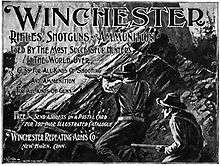.35 Winchester
The .35 Winchester (colloquially .35 Win) cartridge was created in 1903 by the Winchester Repeating Arms Company for use in the Winchester Model 1895 lever-action rifle, and was also available in the bolt action Remington-Lee,[1] or the Model E-10 Factory Sporter Ross Rifle in Canada.
| .35 Winchester | ||||||||||||||||||||
|---|---|---|---|---|---|---|---|---|---|---|---|---|---|---|---|---|---|---|---|---|
| Type | Rifle | |||||||||||||||||||
| Place of origin | USA | |||||||||||||||||||
| Production history | ||||||||||||||||||||
| Designed | 1903 | |||||||||||||||||||
| Manufacturer | Winchester | |||||||||||||||||||
| Produced | 1903-1936 | |||||||||||||||||||
| Specifications | ||||||||||||||||||||
| Bullet diameter | .358 in (9.1 mm) | |||||||||||||||||||
| Neck diameter | .378 in (9.6 mm) | |||||||||||||||||||
| Shoulder diameter | .412 in (10.5 mm) | |||||||||||||||||||
| Base diameter | .457 in (11.6 mm) | |||||||||||||||||||
| Rim diameter | .539 in (13.7 mm) | |||||||||||||||||||
| Case length | 2.41 in (61 mm) | |||||||||||||||||||
| Overall length | 3.16 in (80 mm) | |||||||||||||||||||
| Rifling twist | 1:12 | |||||||||||||||||||
| Primer type | large rifle | |||||||||||||||||||
| Ballistic performance | ||||||||||||||||||||
| ||||||||||||||||||||
| Test barrel length: 24" Source(s): https://shop.ammo-one1.com/images/1501101293183-1618170253.jpeg | ||||||||||||||||||||
Description and performance
Because of the 1895 rifle's box magazine pointed bullets may be used which enhance the long range effectiveness of the cartridge. While obsolete, it is generally considered sufficient for all large game animals in North America. .30-40 Krag brass can be used to form .35 Winchester casings, and the Bertram Bullet Company of Australia manufactures and sells .35 Winchester brass.
It was intended to be a medium-sized caliber falling between the .30-40 Krag and the .405 Winchester, and so it outperformed the .33 Winchester but was less potent than the .348 or .358.[1] Enough at short or medium ranges against moose, elk, or even brown bear, it is suitable for any big game in North America, though it lacks the versatility of more modern rounds.[1]
It was dropped in 1936, along with the M95.[1] Loadings developing 45,000 CUP or over should be avoided in the old M95 lever guns.[1]
Ballistics
| Bullet name & type | Bullet weight (grains) | Powder name | Powder weight (grains) | Muzzle velocity (ft/s) | Muzzle energy (ft·lbf) |
|---|---|---|---|---|---|
| Hornady sp | 200 | IMR 4320 | 52 | 2500 | 2770 |
| Nosler Ballistic Tip | 225 | Alliant Reloader 15 | 50 | 2400 | 2872 |
| Hornady Round Nose | 250 | IMR 4350 | 48.8 | 2400 | 3191 |
| Winchester Silvertip | 250 | IMR 4320 | 48 | 2295 | 2918 |
See also
- List of rifle cartridges
- 9mm caliber
Notes
- Barnes, p.85, ".35 Winchester".
References
- Barnes, Frank C., ed. by John T. Amber. ".35 Winchester", in Cartridges of the World, pp. 85 & 177. Northfield, IL: DBI Books, 1972. ISBN 0-695-80326-3.
- http://www.reloadersnest.com/frontpage.asp?CaliberID=249
- http://www.chuckhawks.com/35Win.htm
